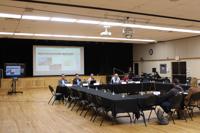San Clemente leaders posed the city as a willing partner and local activists pleaded for sand nourishment during a listening session organized by the Orange County Transportation Authority on Wednesday, March 20.
A few dozen people gathered at the San Clemente Community Center to hear OCTA officials present about their ongoing Coastal Rail Resiliency Study and make their voices heard. Attendees included Mayor Victor Cabral, City Manager Andy Hall, and representatives from Bring Back Our Beaches, Capo Cares, the California Native Plants Society, Save Our Beaches San Clemente and the Surfrider Foundation.
“Placing sand on the beach would accommodate and, I think, address several concerns, including some of the landslides,” Hall said. “Also, the cost of doing that would be comparable, if not less than, building up the revetment.”
The City of San Clemente would eagerly participate in such an action, Hall continued, as residents have expressed critical concern for rebuilding the city’s beaches. Pursuing sand would also placate residents frustrated by OCTA staff’s proposal to do emergency work that would add a half-mile-long wall, a half-mile’s worth of rock placement (riprap), and a revetment three-quarters of a mile long to San Clemente’s beach.
While the city understands OCTA’s need to protect its assets, the riprap is believed to have caused sand to be washed away and thus needs to come with sand whenever it’s placed in the future, Hall said.
During last week’s listening session, the sixth of 10 scheduled and one focused on hearing from “Coastal & Marine Habitat Community-Based Organizations,” OCTA officials presented the audience with the results from the CRRS’ Initial Assessment. The information was the same as that presented to the OCTA Board of Directors at their March 11 meeting.
OCTA identified seven monitoring areas stretching from Doheny State Beach to the OC-San Diego County border that need various levels of continuous monitoring.
It also marked four potential reinforcement areas to place riprap, construct a revetment and do other work to address the impacts of erosion and poor surface drainage. The stretch from North Beach to Linda Lane and the northern end of the Cyprus Shores area comprised the reinforcement areas.
“These are the four areas that we have identified as being an imminent threat to the continued operation of the railroad, and, in fact, (the Linda Lane area) has already set in motion,” said project manager Dan Phu. “That underscores the importance of needing to get something done sooner rather than later.”
Suzie Whitelaw, a member of Save Our Beaches SC, cited a peer review of OCTA’s request for proposals (RFP) and work plan completed by Brett Sanders, a professor at the University of California, Irvine. The peer review discovered a lack of an emphasis on sand in the documents, Whitelaw said, calling out OCTA for not meaningfully looking into sand nourishment as an option to protect the railroad.
“This is not a short-term solution to your problem,” she said of constructing seawalls comprising rock. “This is a long-term destruction of our beaches. This is death to our beaches.”
Mandy Sackett, Surfrider’s Senior California Policy Coordinator, expressed Surfrider’s opposition to the proposed projects and stated the projects should be undergoing the California Coastal Commission’s full permitting process.
Rock placement will do serious damage to public resources, she continued, adding that any plans to establish seawalls should come with an “extremely robust mitigation package” and substantial placement of sand.
“We also wish to see the extension of the coastal trail south of the railroad and a firm commitment to relocating the rail by 2035, similar to Del Mar’s commitment,” said Sackett.
Capo Cares’ Toni Nelson cautioned OCTA against destroying South Orange County beaches for generations to come and echoed Surfrider’s request for OCTA to submit to the full CCC permitting process.
“This is not an emergency; when you have an emergency that keeps happening over three years, it’s now normal,” Nelson said. “This is your new normal, and you need to go through the normal litigation.”
During the meeting, Project Manager Phu stated that OCTA staff are looking into placing sand in addition to other concepts, and that the reluctance with sand is more related to the timeframe required to place it.
“Sand is definitely going to be part of the solution,” Phu said.
The public listening sessions will continue as the CRRS enters the phases of drafting evaluation criteria and initial project concepts this spring. Christina Byrne, OCTA Public Outreach Department Manager, said the objective of the sessions is to gather and document community feedback as the organization seeks to maintain the rail line and minimize service disruptions.
The next session, concerning homeowner associations and residential groups, is scheduled for April 3. A virtual meeting for the general public will occur on April 11, followed by a roundtable for elected officials on May 10 and an in-person meeting for the general public on May 30.
The final meeting is anticipated to occur in the Council Chambers at San Clemente City Hall, according to Byrne.
More information about the CRRS is available at octa.net.


